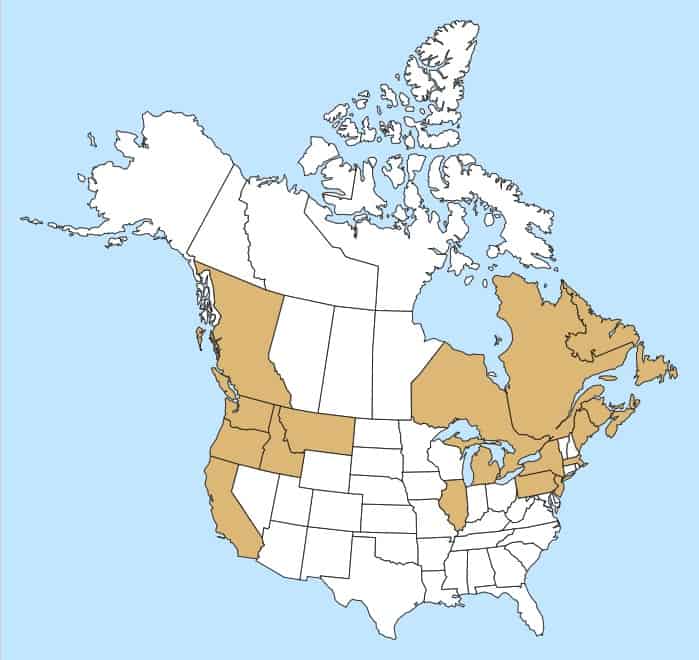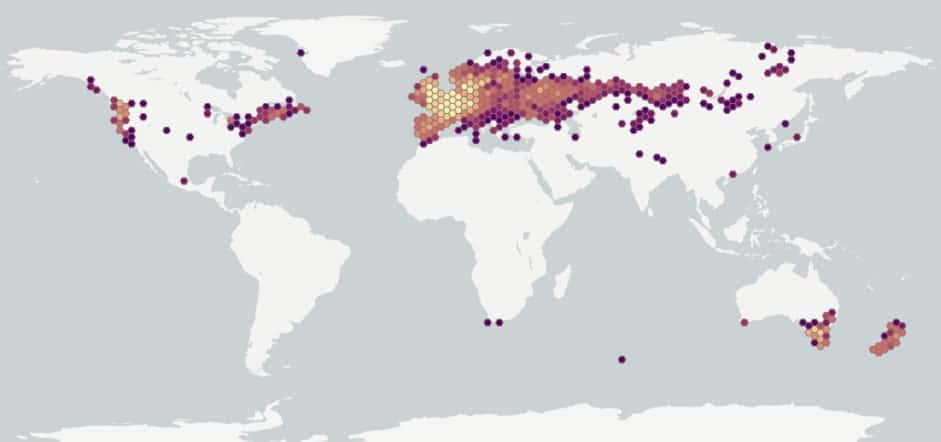Jacobaea vulgaris
Overview
Aperçu
Regulation :
Remarques Réglementation:
- CFIA Weed Seeds Order - Class 2: Primary Noxious Weed Seeds
- Quarantine lists of countries e.g. India *may be updated without notice
Regulation Notes:
Distribution :
Répartition :
Native to northern Africa, Europe and temperate Asia and introduced in North America, China, Australia, New Zealand, and beyond its native range in Europe (Finland, Norway, Russia) (USDA-ARS 2020). In the United States, it occurs mostly in the west and northeastern regions (Kartesz 2015). Occurs in Canadian provinces of British Columbia, Manitoba, New Brunswick, Newfoundland and Labrador, Nova Scotia, Ontario, Prince Edward Island, Quebec, (Brouillet et al. 2010+).
Habitat and Crop Association :
Habitat et Cultures Associées :
Pastures, hay fields, old fields, roadsides, railway lines and disturbed areas (Bain 1991; Darbyshire 2003). Not a known weed of crops, however a problem in pastures due to toxicity (Royer and Dickinson 1999).
Economic Use, cultivation area, and Weed Association :
Utilisation économique, zone de culture et association de mauvaises herbes :
Duration of Life Cycle :
Durée du cycle vital:
Biennial or Perennial
Dispersal Unit Type :
Type d’unité de dispersion :
Achene
General Information
RENSEIGNEMENTS GÉNÉRAUX
Jacobaea vulgaris is thought to have been introduced into Canada in the 1850s in ship ballast (Bain 1991). J. vulgaris contains alkaloids which are toxic to cattle, deer, horses and goats (Royer and Dickinson 1999).
A single plant can produce as many as 150,000 seeds, which can remain viable for over 20 years (BC MAFF 2002). The achenes from disc florets have both a pappus and hairs for wind and animal dispersal, and the ray achenes are heavier, without dispersal mechanisms, and stay in the flower head for months after maturity (CABI 2020).
.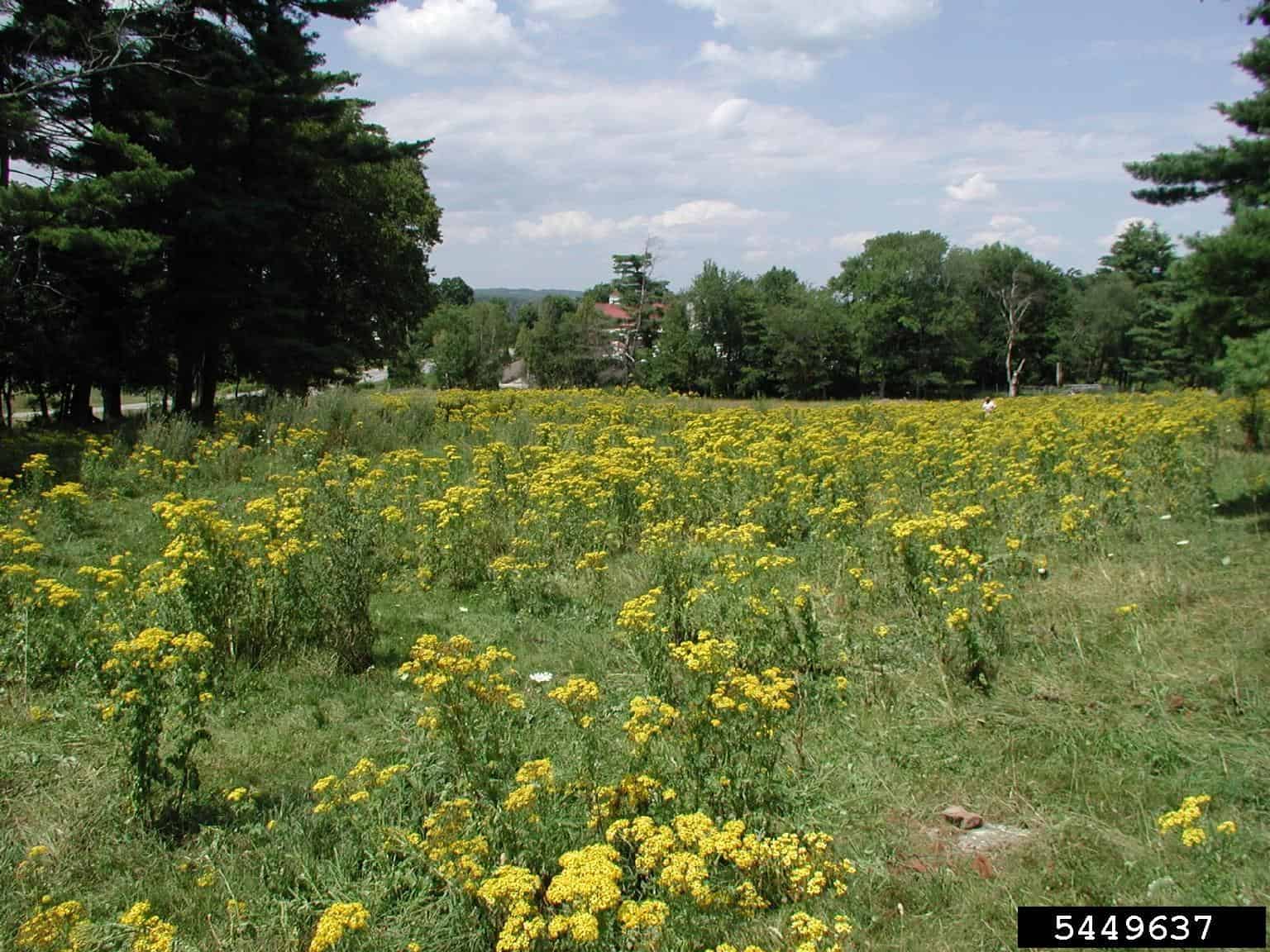
Jacobaea vulgaris infestation (Leslie J. Mehrhoff, University of Connecticut, Bugwood.org)
Identification
Identification
-
Dimorphic Achene: achene with pappus
Size
- Achene length*: 1.2 – 2.0 mm; width: 0.4 – 0.7 mm
*Note: minimum and maximum of 20 achenes in a normal range of this species using image measurement (ISMA 2020)
Shape
- Achene cylindrical, straight or slightly curved longitudinally, tapered at one end, the other truncate
Surface Texture
- Achene surface is stippled with sparse, short, yellow hairs between several longitudinal, wide ribs
Colour
- Achene is shining light yellow or yellow brown, may be the same colour or reddish-brown between the ribs
Other Features
Pappus
- A persistent pappus of thin, white bristles up to 6.0 mm (eFloras 2020) may be attached to the achene, and is removed during processing (CABI 2020)
Achene end with pappus
- The achene is constricted below the rim of the truncate end, making this end appear flared out
- A short style remnant is at the center of the truncate end, generally not visible from side view
Achene end without pappus
- A small ring of tissue is at the center of this end
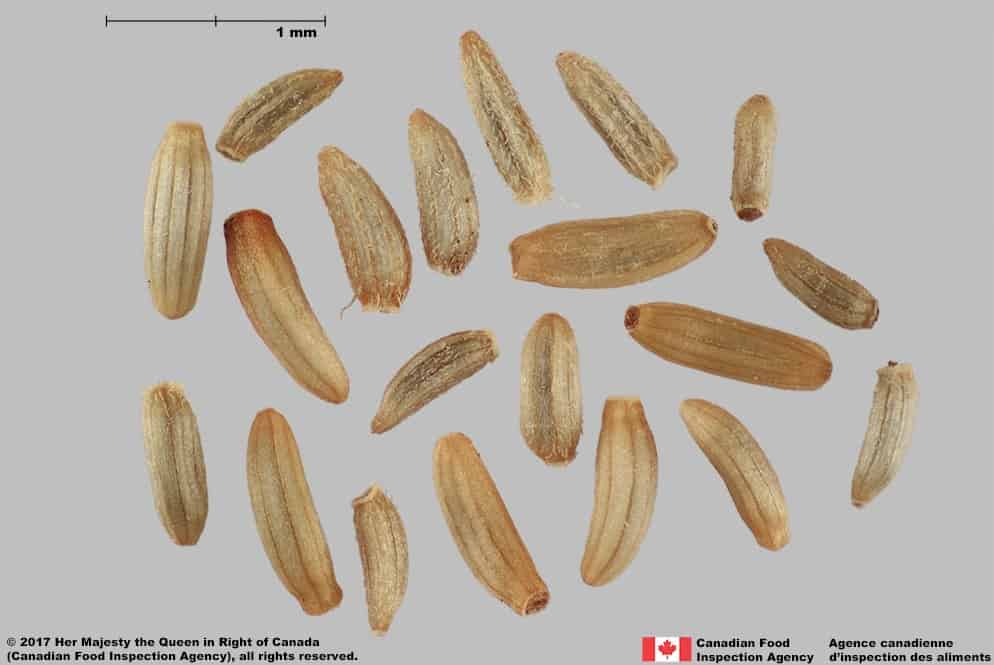
Tansy ragwort (Jacobaea vulgaris); achenes

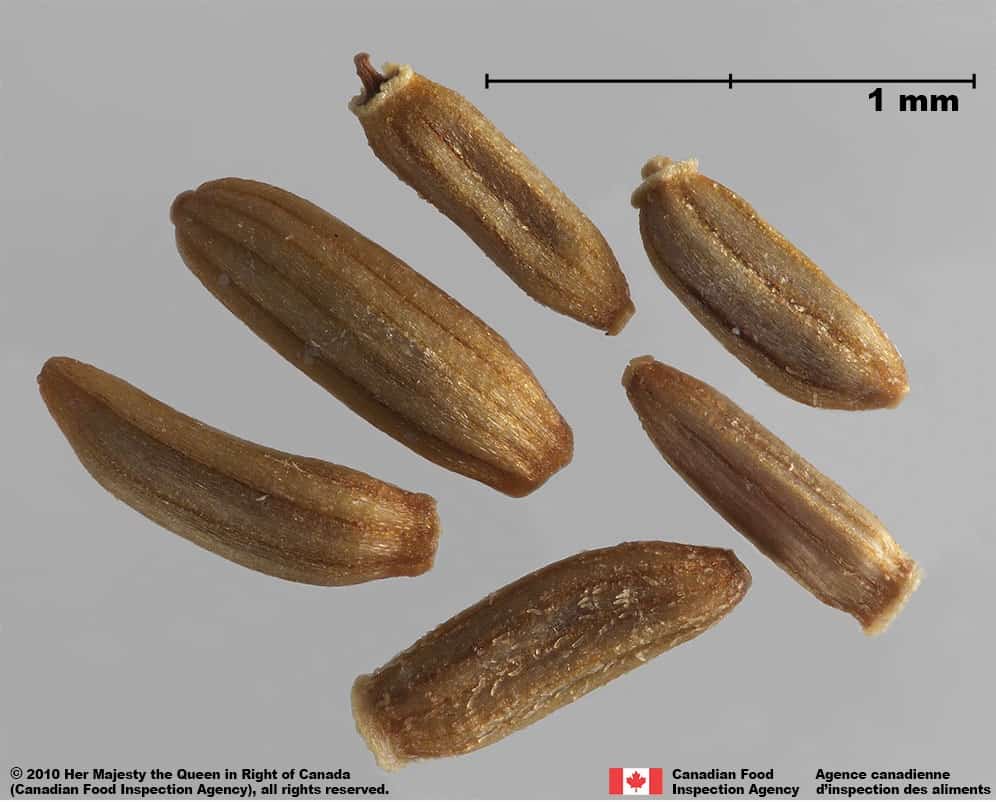
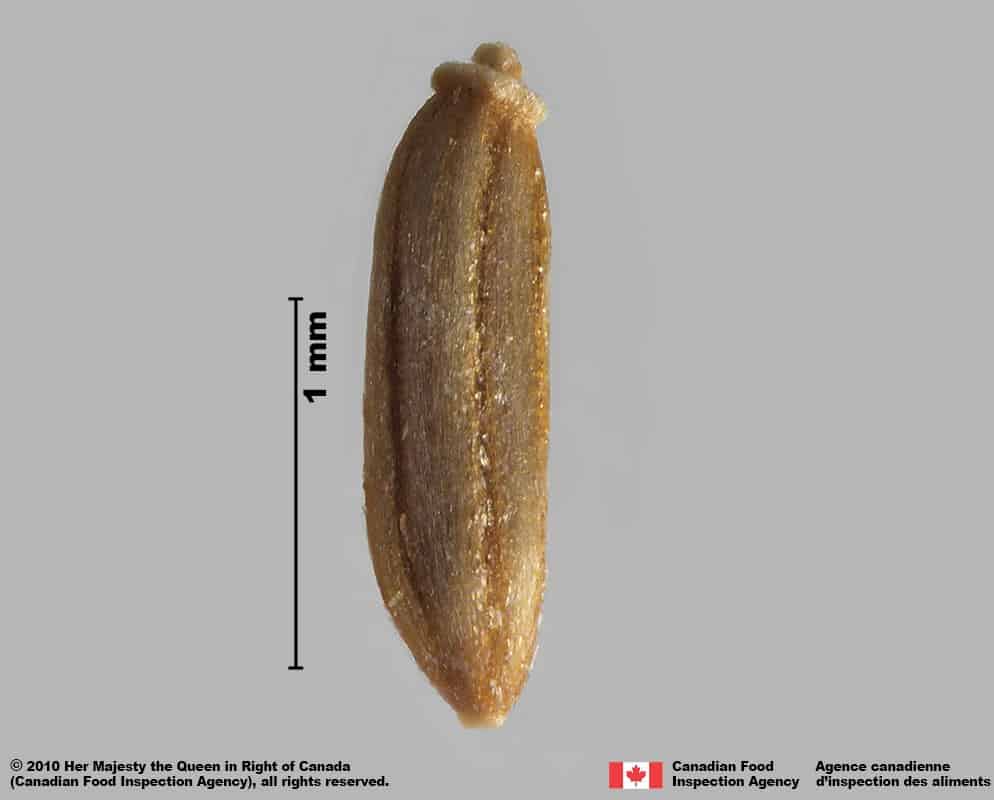
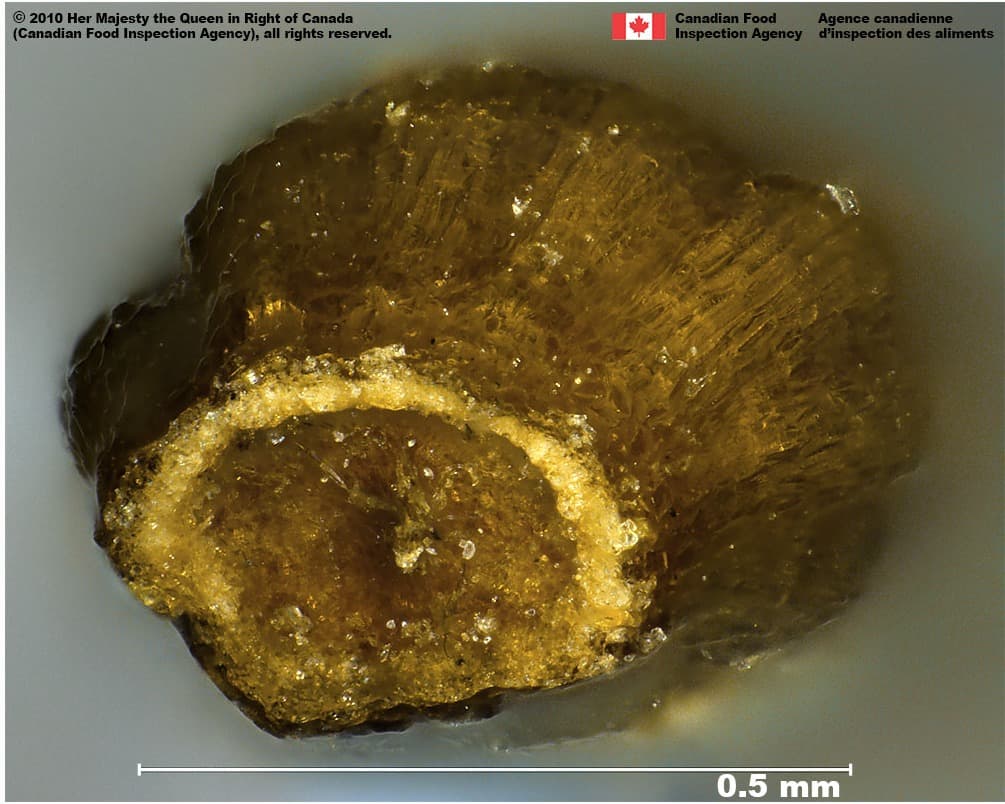
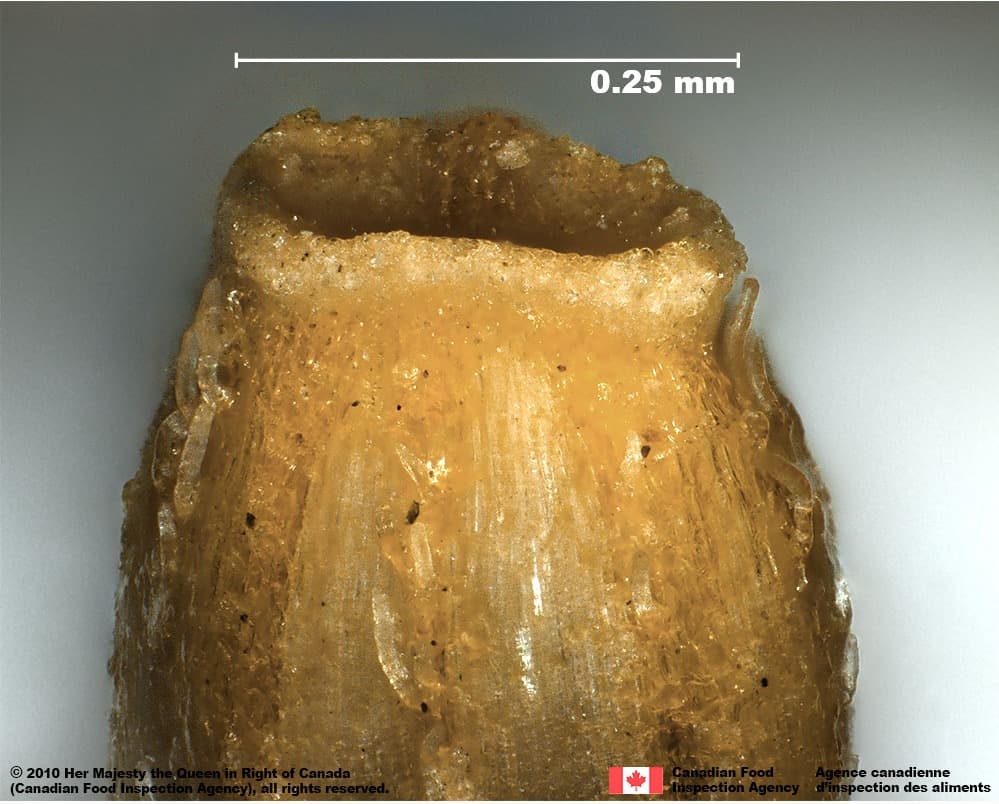
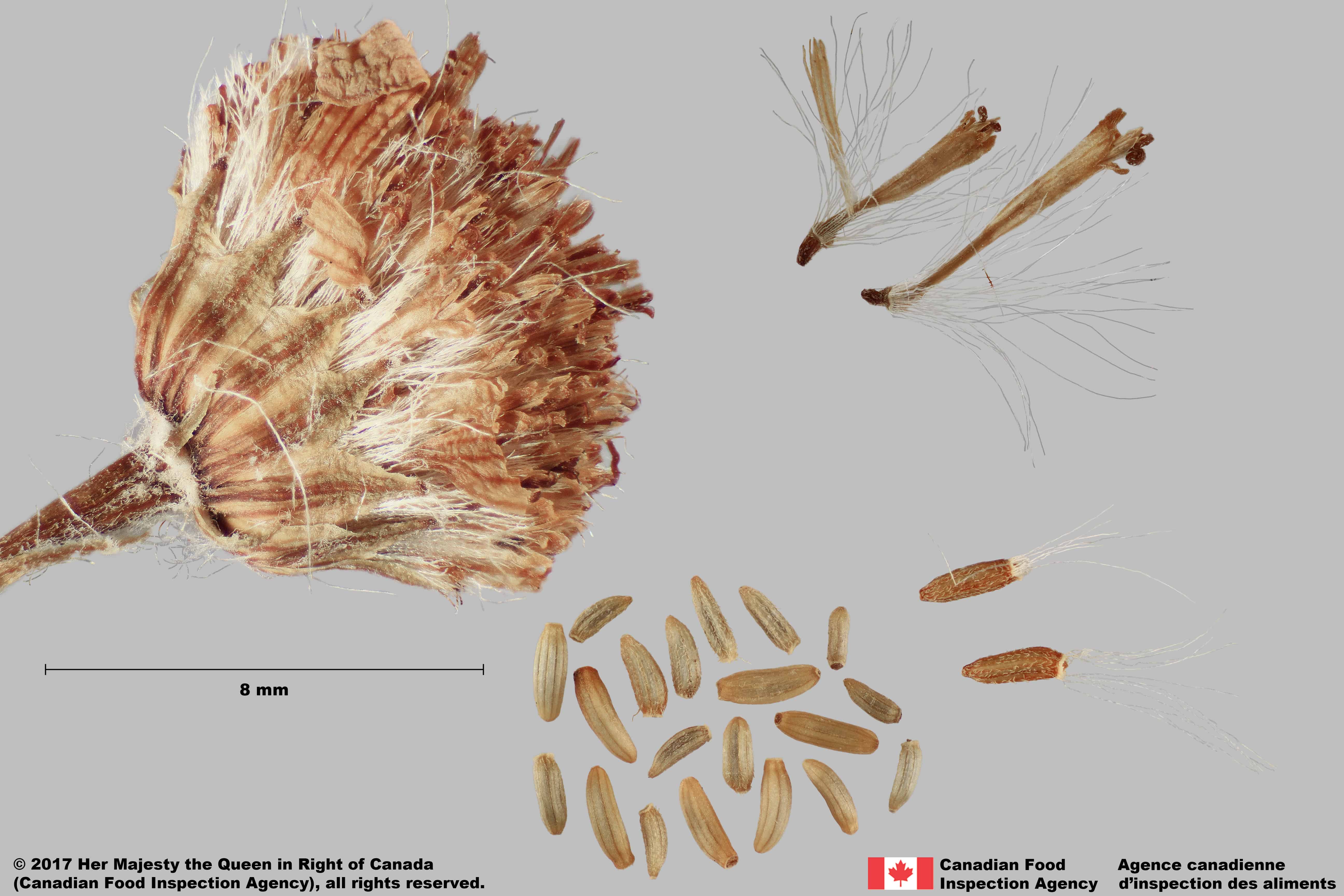
-
Dimorphic Achene: achene without pappus
Size
- Achene length*: 1.2 – 2.0 mm; width: 0.4 – 0.7 mm
*Note: minimum and maximum of 10 achenes in a normal range of this species using image measurement (ISMA 2020)
Shape
- Achene cylindrical, straight or slightly curved longitudinally tapered at one end, the other is truncate
Surface Texture
- Achene surface is stippled, without hairs and several longitudinal, wide ribs
Colour
- Achene is shining light yellow or yellow brown, can be the same colour or reddish-brown between the ribs
Other Features
Pappus
- A pappus of thin, white bristles up to 6.0 mm may be attached to immature achenes, but does not persist on mature achenes (eFloras 2020)
Achene end with pappus
- The achene is constricted below the rim of the truncate end, making this end appear flared out
- A short style remnant is at the center of the truncate end, generally not visible from side view
Achene end without pappus
- A small ring of tissue is at the end attached to the flower head

Tansy ragwort (Jacobaea vulgaris); achenes

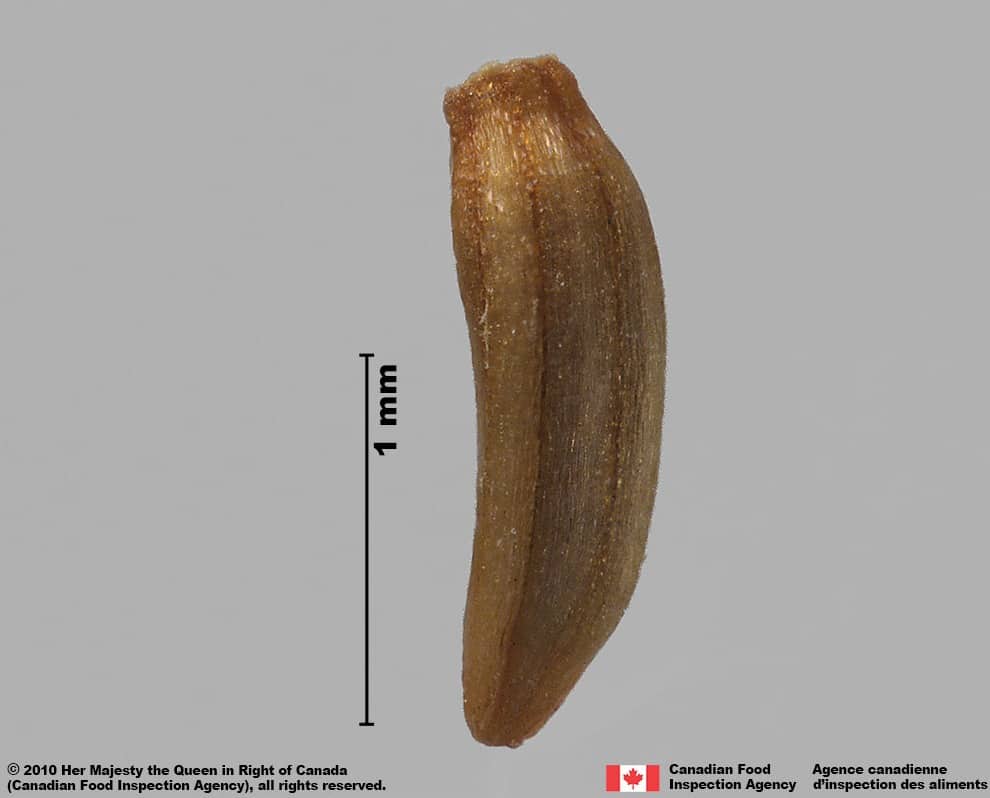



-
Seed
Size
- Seed size similar to achene size
Shape
- Seed is oblong
Surface Texture
- Seed is smooth
Colour
- Seed is grey
Other Features
- Seed coat thin, whitish coloured, adhering to the fruit wall
-
Embryo
Size
- Embryo fills the seed
Shape
- Embryo is spatulate, axial position
Endosperm
- Endosperm absent, nutritive tissue stored in the cotyledons
Other Features
- Cotyledons are soft-textured
Identification Tips
CONSEILS POUR L’IDENTIFICATION
Achenes of Jacobaea vulgaris can be distinguished from other Jacobaea species and Senecio species by their yellowish brown colour, wider achenes, and the short, yellow and more sparse surface hairs than the other species.

Tansy ragwort (Jacobaea vulgaris); achenes






Additional Botany Information
AUTRES RENSEIGNEMENTS BOTANIQUES
Flowers/Inflorescence
- Flowers yellow, daisy-like with both disc and ray florets
- The achenes with a pappus are more commonly encountered than the achenes without a pappus from the florets around the outside of the flower head (eFloras 2020)
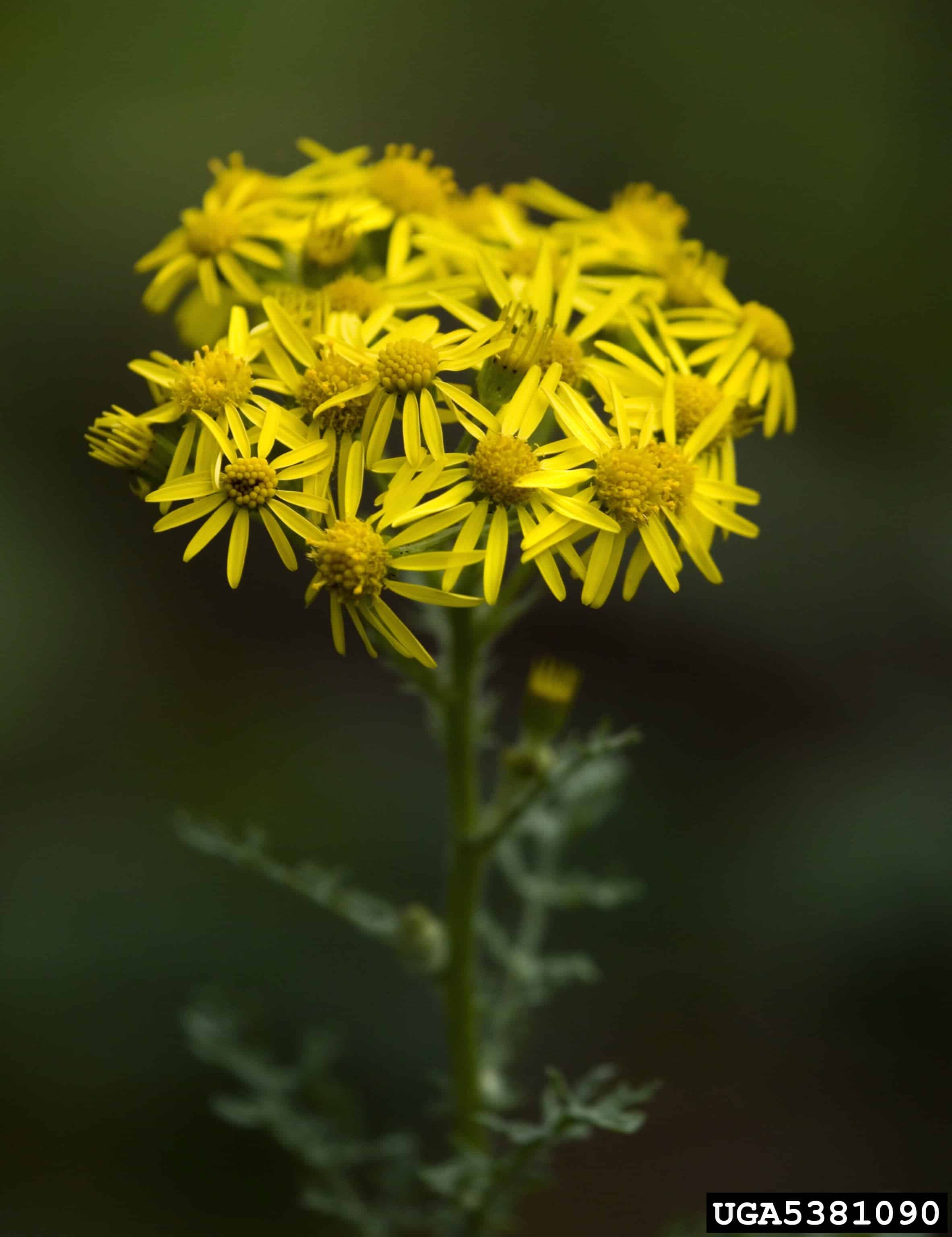
Jacobaea vulgaris inflorescence (Leslie J. Mehrhoff, University of Connecticut, Bugwood.org)

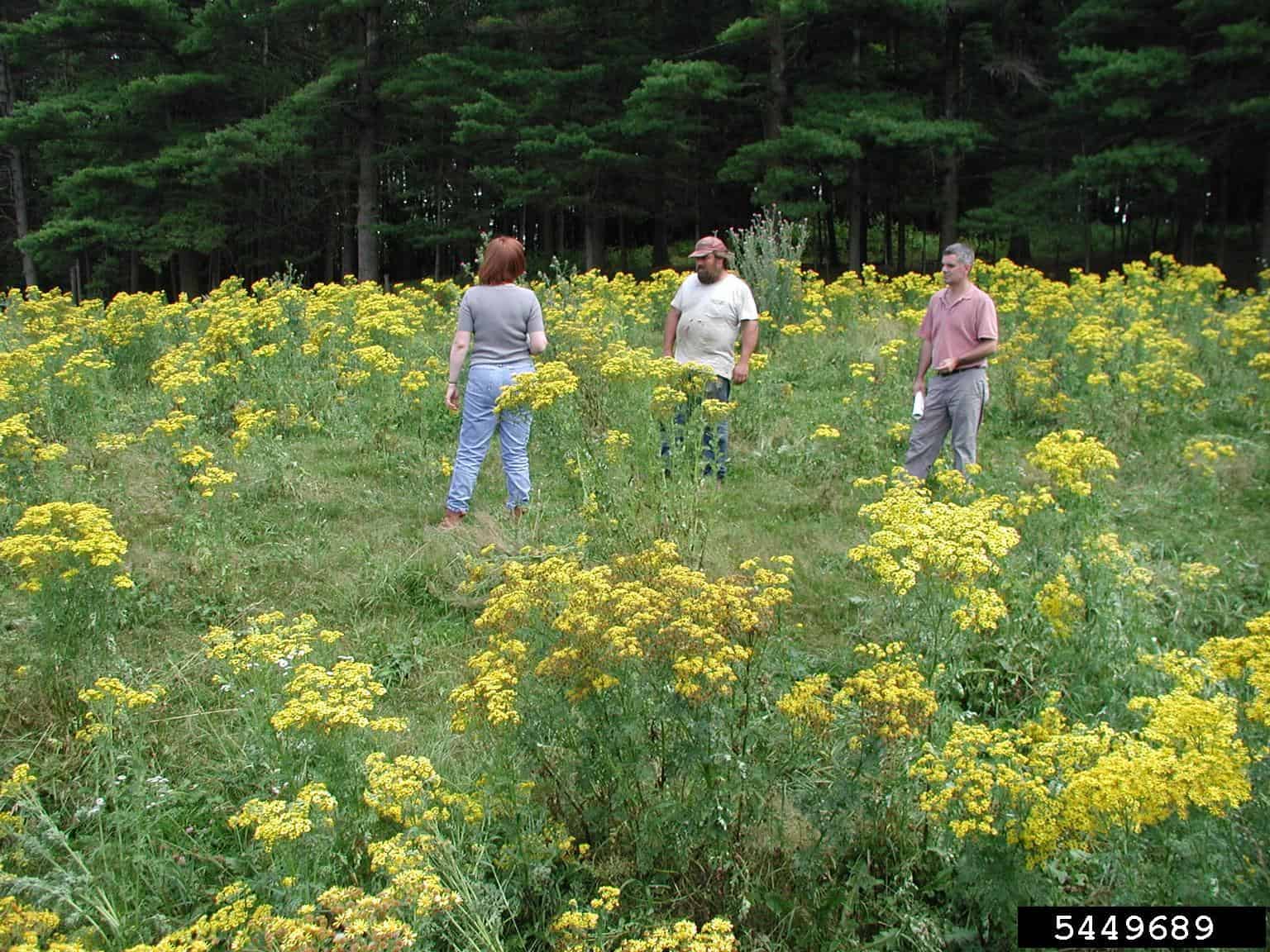
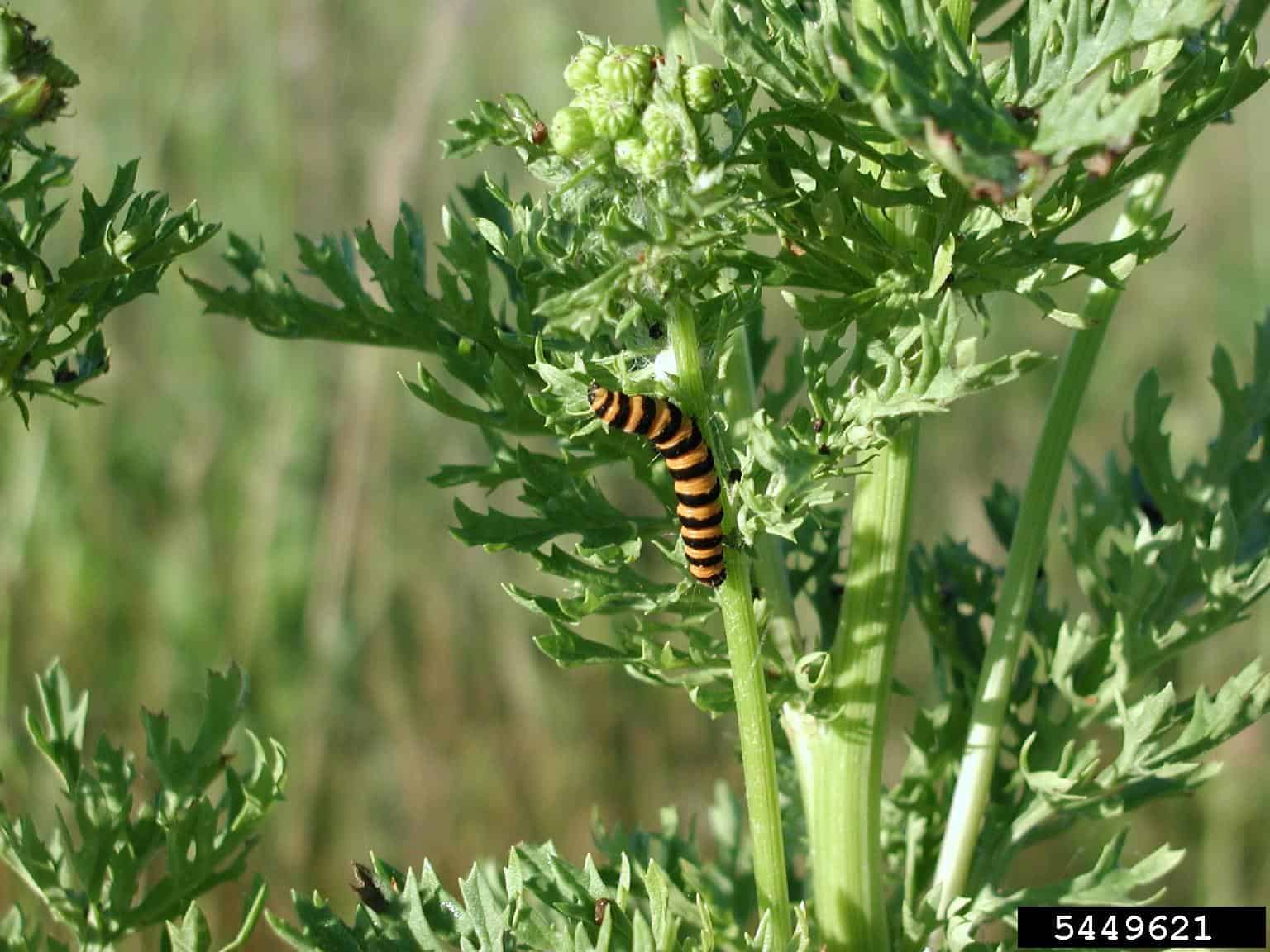
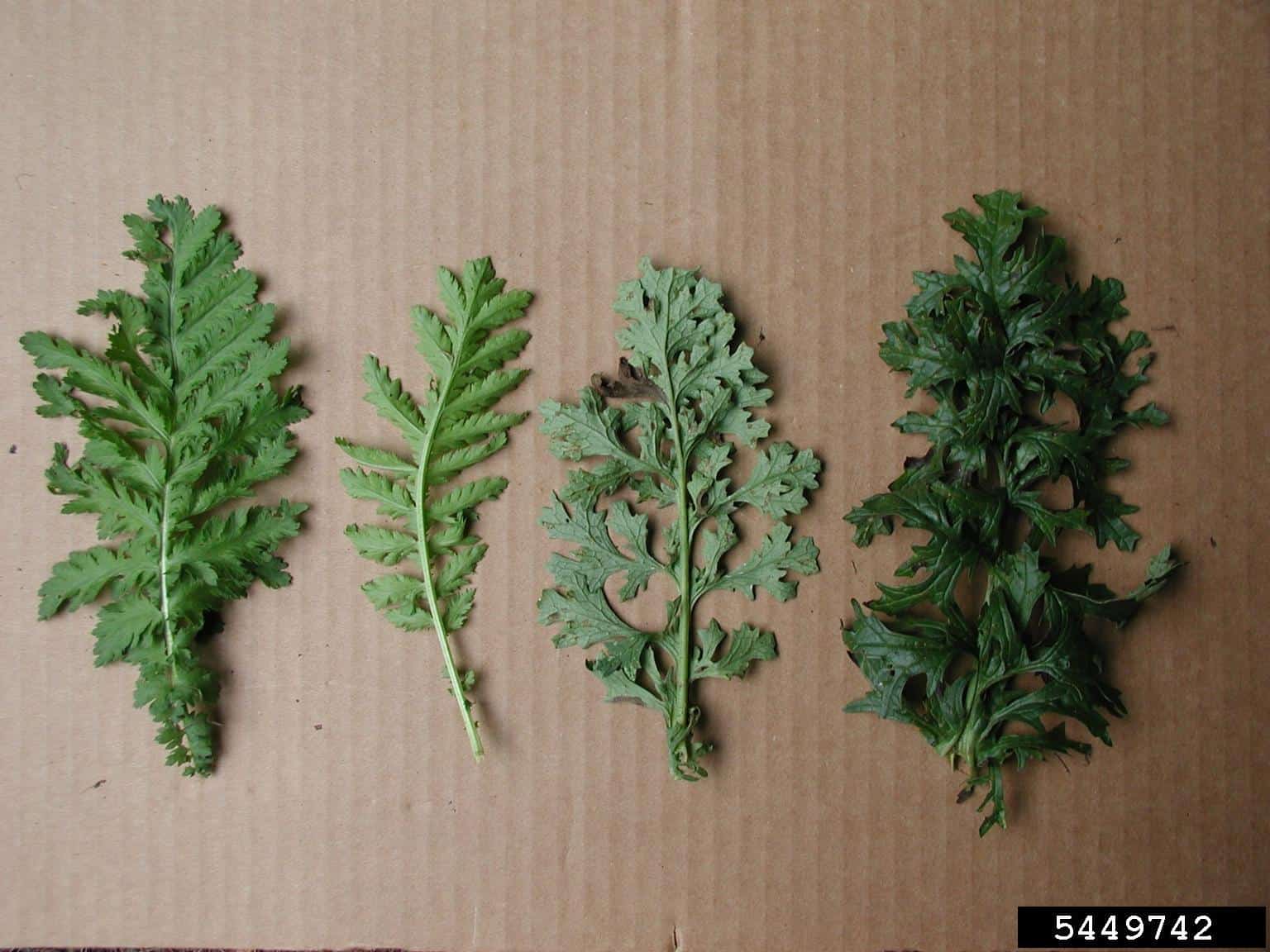
Similar Species
ESPÈCES SEMBLABLES
Similar species are based on a study of seed morphology of various species, and those with similar dispersal units are identified. The study is limited by physical specimen and literature availability at the time of examination, and possibly impacted by the subjectivity of the authors based on their knowledge and experience. Providing similar species information for seed identification is to make users aware of similarities that could possibly result in misidentification.
Jacobaea maritima (L.) Pelser & Meijden (dusty miller)
J. maritima achenes are generally longer (length*: 1.8 – 2.8 mm; width: 0.5 – 1.0 mm), without surface hairs and do not have a flared pappus end compared to J. vulgaris achenes. The achene is dark brown between the ribs, rather than the same colour or reddish brown colour in J. vulgaris.
*Note: minimum and maximum of 10 achenes in a normal range of this species using image measurement (ISMA 2020)
Click to select species
Cliquez pour sélectionner les espèces
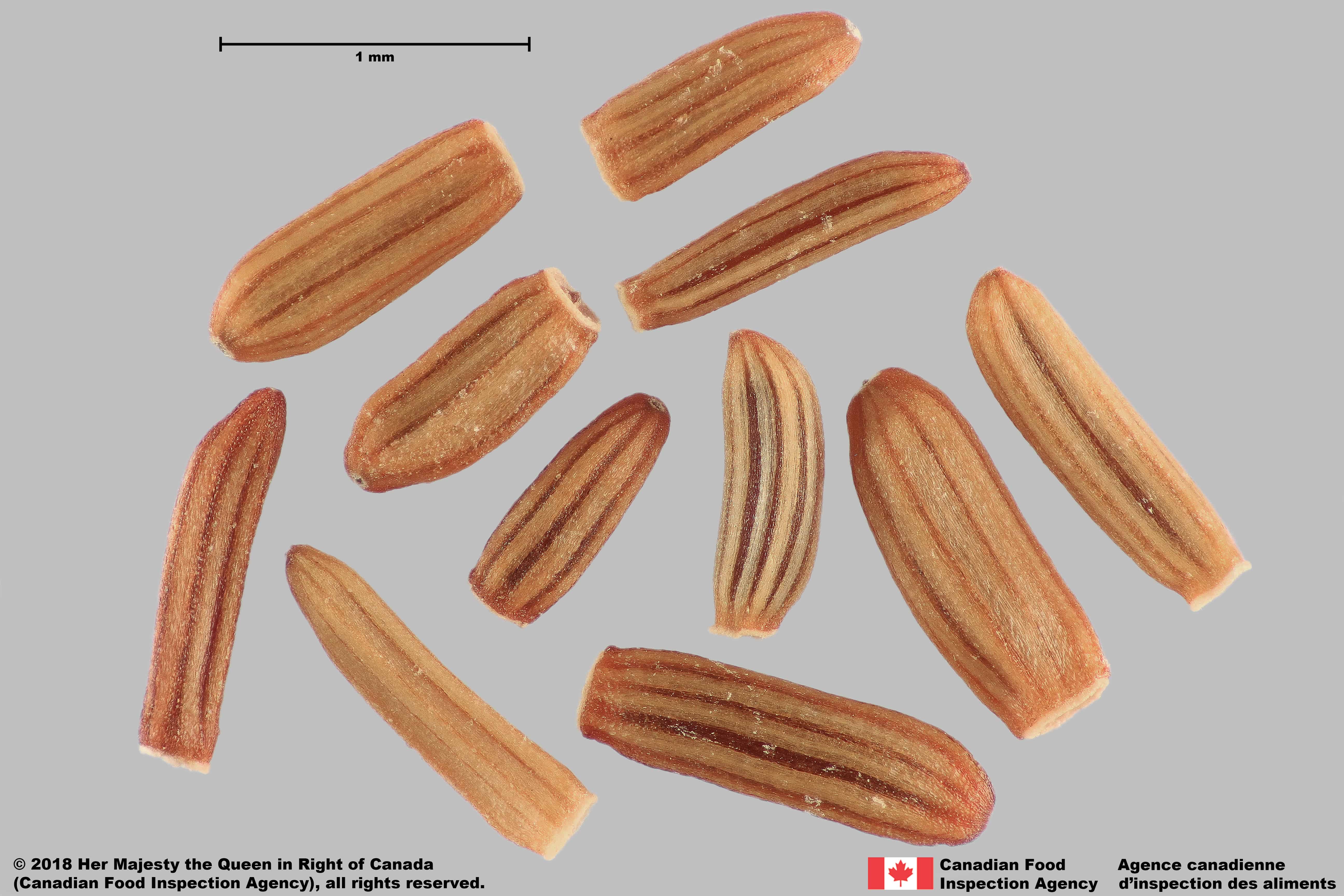
Jacobaea maritima
Comparison Window
Fenêtre de comparaison
MAIN SPECIES
ESPÈCES PRINCIPALES
Jacobaea vulgaris

Jacobaea vulgaris
Asteraceae
Tansy ragwort (Jacobaea vulgaris); achenes
MAIN SPECIES
ESPÈCES PRINCIPALES
Jacobaea vulgaris

Jacobaea vulgaris
Asteraceae
Tansy ragwort (Jacobaea vulgaris); achenes
MAIN SPECIES
ESPÈCES PRINCIPALES
Jacobaea vulgaris

Jacobaea vulgaris
Asteraceae
Tansy ragwort (Jacobaea vulgaris); achene
MAIN SPECIES
ESPÈCES PRINCIPALES
Jacobaea vulgaris

Jacobaea vulgaris
Asteraceae
Tansy ragwort (Jacobaea vulgaris); achene
MAIN SPECIES
ESPÈCES PRINCIPALES
Jacobaea vulgaris

Jacobaea vulgaris
Asteraceae
Tansy ragwort (Jacobaea vulgaris) achene, collar (top-down view)
MAIN SPECIES
ESPÈCES PRINCIPALES
Jacobaea vulgaris

Jacobaea vulgaris
Asteraceae
Tansy ragwort (Jacobaea vulgaris) achene, collar (side view)
MAIN SPECIES
ESPÈCES PRINCIPALES
Jacobaea vulgaris

Jacobaea vulgaris
Asteraceae
Jacobaea vulgaris seed head, achenes, and immature achenes
SIMILAR SPECIES
ESPÈCES SEMBLABLES
Jacobaea maritima

Jacobaea maritima
Asteraceae
Jacobaea maritima achenes
SIMILAR SPECIES
ESPÈCES SEMBLABLES
Jacobaea maritima
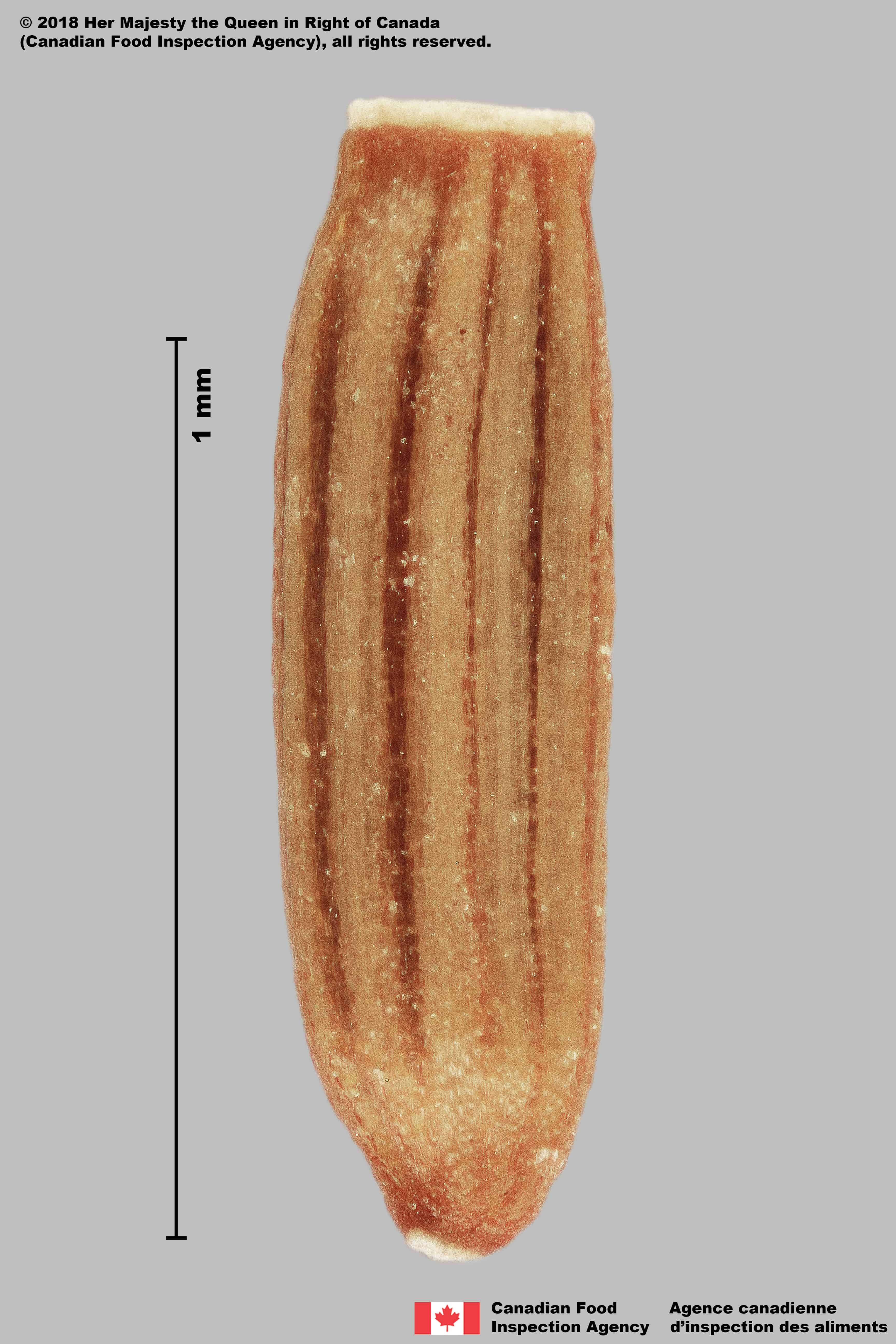
Jacobaea maritima
Asteraceae
Jacobaea maritima achene
SIMILAR SPECIES
ESPÈCES SEMBLABLES
Jacobaea maritima
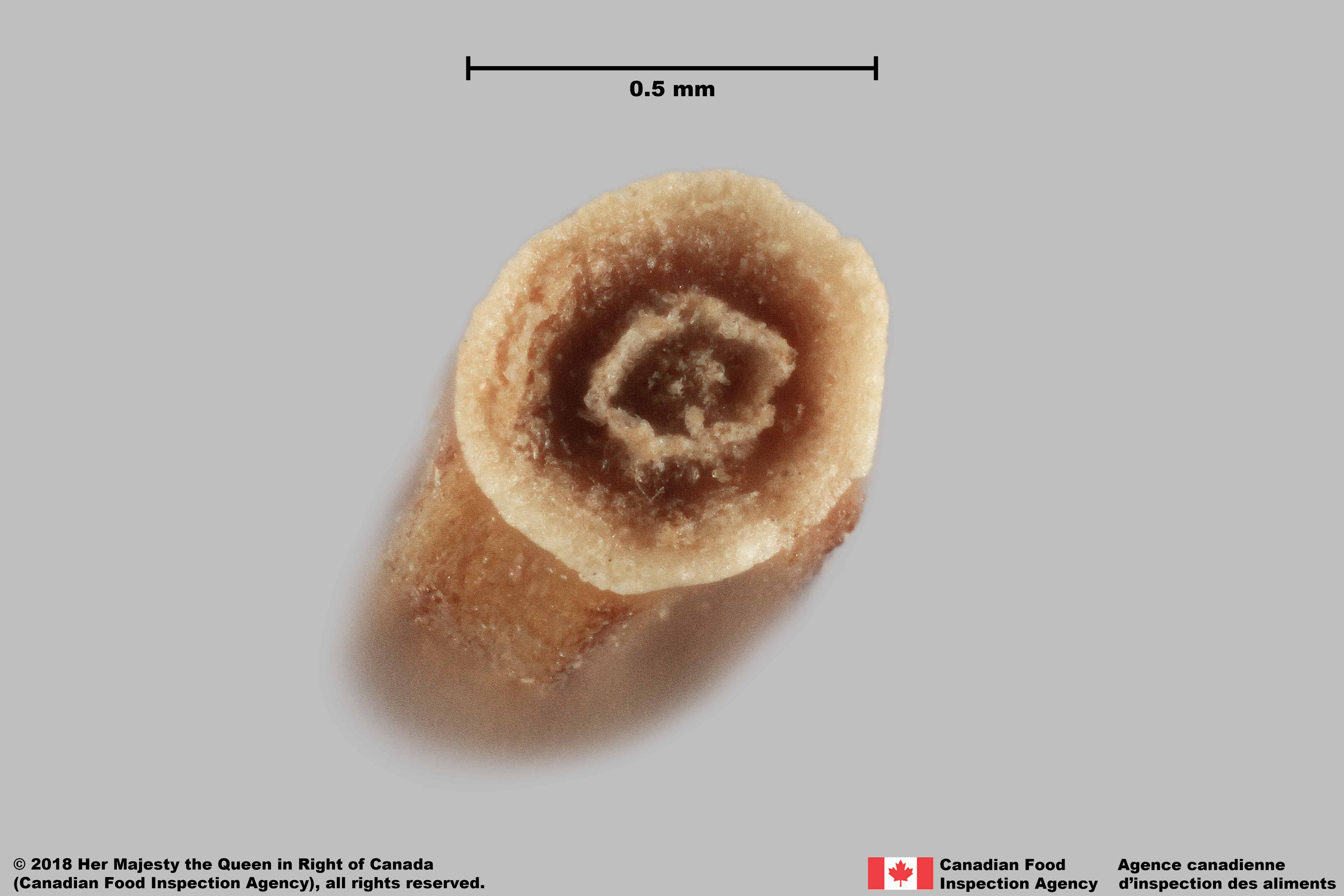
Jacobaea maritima
Asteraceae
Jacobaea maritima achene end
Need ID Help?
Besoin d’aide pour l’identification?
Reference(s)
Référence(s)
Bain, J. F. 1991. The biology of Canadian weeds. 96. Senecio jacobaea L. Canadian Journal of Plant Science 71: 127-140.
British Columbia Ministry of Agriculture, Food and Fisheries (BC MAFF). 2002. Guide to weeds in British Columbia. Open Learning Agency, Burnaby, British Columbia, Canada. 195 pp.
Brouillet, L., Coursol, F., Meades, S. J., Favreau, M., Anions, M., Bélisle, P. and Desmet, P. 2010+. VASCAN, the database of vascular plants of Canada. http://data.canadensys.net/vascan/ Accessed November 23, 2020.
Centre for Agriculture and Bioscience International (CABI). 2020. Invasive Species Compendium, CAB International, Wallingford, UK. https://www.cabidigitallibrary.org/journal/cabicompendium Accessed November 23, 2020.
Darbyshire, S. J. 2003. Inventory of Canadian Agricultural Weeds. Agriculture and Agri-Food Canada, Research Branch. Ottawa, ON.
eFloras. 2020. Electronic Floras. Missouri Botanical Garden, St. Louis, MO & Harvard University Herbaria, Cambridge, MA., http://www.efloras.org Accessed August 19, 2020.
Flora of North America (FNA) Editorial Committee, eds. 1993+. Flora of North America North of Mexico [Online]. 22+ vols. New York and Oxford. Accessed December 29, 2022.
Global Biodiversity Information Facility (GBIF) Secretariat. 2022. https://doi.org/10.15468/39omei Accessed via https://www.gbif.org/species/5388602 Accessed December 29, 2022.
Government of Canada (GC). 2016. Canadian Weed Seeds Order. https://laws-lois.justice.gc.ca/eng/regulations/SOR-2016-93/page-2.html (English) https://laws-lois.justice.gc.ca/fra/reglements/DORS-2016-93/page-2.html (French)
International Seed Morphology Association (ISMA). 2020. Method for Seed Size Measurement. Version 1.0. ISMA Publication Guide. https://www.idseed.org/authors/details/method_for_seed_size_measurement.html
Kartesz, J. T. 2015. The Biota of North America Program (BONAP). North American Plant Atlas. Chapel Hill, N.C., www.bonap.org/MapSwitchboard.html Accessed November 23, 2020.
Royer, F. and Dickinson, R. 1999. Weeds of Canada and the Northern United States. The University of Alberta Press/Lone Pine Publishing, Edmonton, Alberta.
U.S. Department of Agriculture-Agricultural Research Services (USDA-ARS). 2020. Germplasm Resources Information Network (GRIN), https://npgsweb.ars-grin.gov/gringlobal/taxon/taxonomysimple.aspx Accessed November 23, 2020.



